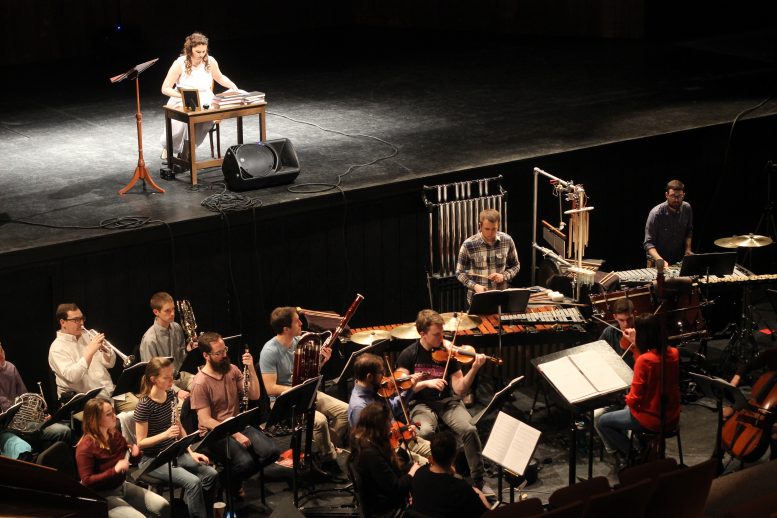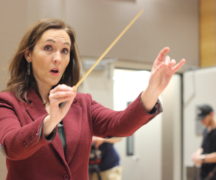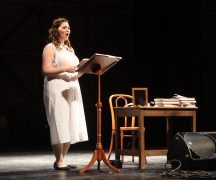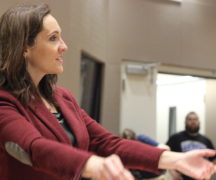By DAVID DUPONT
BG Independent News
Emilie de Chatelet defied the social gravity of her time, rising to prominence as an intellectual in the fields of physics, math, and philosophy in early 18th century France.
She was a passionate woman, whose love life and intellectual life were woven together. She was married, and had affairs, including with French philosopher Voltaire.
“Emilie,” a one-woman opera by composer Kaija Saariaho and her librettist author Amin Maalouf, depicts de Chatelet as she is completing her French translation of Isaac Newton’s seminal text “Principia” from Latin.

From left, Hillary LaBonte, Maria Mercedes Diaz Garcia, and Ariel Kosta.
Two women from Doctorate in Contemporary Music Program are teaming up to bring “Emilie” to the stage for a free performance Thursday, April 5, at 6 p.m. at Kobacker Hall on the Bowling Green State University. Soprano Hillary LaBonte will perform as the heroine in the one-person opera, and Maria Mercedes Diaz Garcia will conduct the VIVE! Ensemble. This is the first time the 2010 opera has been performed in the Midwest.
LaBonte was looking for a contemporary opera featuring a strong female character.
Diaz Garcia came upon the opera during her research into Saariaho’s work as part of her dissertation, which is about the way the Finnish composer’s manipulates time.
The opera is small scale using a small orchestra, no choir, and one soloist, a soprano. “I thought it was perfect. It was for the soprano we have in the program, for Hillary.”
LaBonte is excited about portraying Emilie. “She is fascinating because she was exceptional, working at a time when women were not allowed in certain circles of intellectual society. Her father made sure she got a complete education, which was not normal at time. She dug into everything that was happening in intellectual society, blending science, language, math, philosophy.”
When she was younger she couldn’t afford books, so she developed successful gambling strategies.
“She met Voltaire, and they recognized each other as intellectual equals,” LaBonte said.
The opera finds her in the late stages of pregnancy working on the translation of “Principia.”
“She had this sense of foreboding that she wasn’t going to complete this translation before this baby was born.” LaBonte said.
She did, including all the commentaries and proofs, but died from complications of childbirth just nine days after she delivered her son.
Her translation sat for several years, until it was discovered and published. It is still considered the standard translation of Newton’s work.
Though the soprano is the only singer, Emilie’s is not the only voice in the opera. The composer employs electronics to alter the soprano’s voice to make it sound like a man’s or like a child’s.
Diaz Garcia said the character “is actually remembering the past, and all the characters who appear are personified by Hillary.”
“The effect is really striking,” LaBonte said. “When you have a vivid memory of someone, it’s usually the sound and what it is to be around them. This is an interesting tool she uses to make that happen.”
The harpsichord, played by Ariel Kosta, also in the doctoral program, is electronically manipulated as well.
The harpsichord, selected by the composer because de Chatelet played the instrument, is prominently featured, often in dialogue with the voice, he said.
He’s only played harpsichord a couple times before, and that playing music from the Baroque era. This is also his first time playing the music of Saariaho.
“It’s an interesting sound world,” he said. Now he is considering learning one of her pieces for solo harpsichord and electronics and performing on one of his three required recitals.
“Emilie,” LaBonte said, is not the usual plot-driven opera, such as Mozart’s “Cosi fan tutte,” which she starred in just a couple weeks ago. In those operas, the characters’ reflections come out in the arias.
“Emilie” is all arias, a series of nine. The composer and librettist “describe a very complex figure with all these aspects of a woman not often portrayed,” Diaz Garcia said. The electronics do justice to the complexity of Emilie.
“Saariaho is very interesting from many different perspectives,” the composer said. “She works with a lot of timbre and textures. She takes you into the world.”
The music reflects Emilie’s passion, both in love and scholarship.
True to the character, the story is told in a multitude of languages – French, Italian, English, and Latin. The text will be projected in English supertitles.
For now this will be the only performance, though the conductor had hoped to stage it elsewhere.
“It would be great to take the work to other places,” LaBonte said. “I’d love to see that. I’d love to do it.”
Diaz Garcia added: “We’d like to keep the door open.”
The Vive! Ensemble, which Diaz Garcia formed, has a series of dates in Cincinnati, Nashville, and Dallas scheduled in spring and summer that will feature premiere performances of works by emerging composers.





